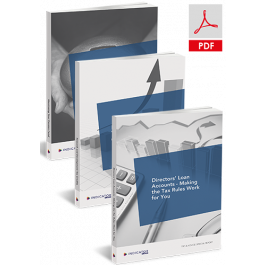3 PDFs to cut your tax bill
A 40% saving on the package!
-
 Maximising Your Pension Fund (PDF)
Maximising Your Pension Fund (PDF)
-
 Research and Development Tax Credits (PDF)
Research and Development Tax Credits (PDF)
-
 Directors' Loan Accounts - Making the Tax Rules Work for You (PDF)
Directors' Loan Accounts - Making the Tax Rules Work for You (PDF)
A Tips & Advice Special Report about...
In a nutshell
This Special Report helps you maximise the value of your pension fund. It covers the latest pension rules including pension annual allowance tapering and how they affect your pension scheme. It also offers a host of ideas to get the most out of your pension savings. Whatever your situation, this Special Report ensures your efforts to build up your pension fund are properly rewarded through effective tax planning.
In detail
With so many changes to the pension rules over recent years, it’s difficult to keep up. This Special Report brings you quickly up to speed and answers important questions such as:
- Which different types of pension exist?
- How do you make cost-effective pension contributions?
- What are the options to withdraw money from your fund tax-efficiently?
- What are effective tax planning strategies?
This Special Report, crammed with useful advice, will help you keep more money in your retirement pocket and out of HMRC’s.
We've created this Tips & Advice Special Report especially for...
Business owners, company directors and anyone with a pension that wants to:
- Know which pension schemes work best in their situation
- Build up a pension fund in a safe and tax-effective way
- Get the most from future pension savings
Financial advisors and accountants that want to:
- Be aware of all the complicated pension rules scheme for their clients
You'll get the following free extras with this Tips & Advice Special Report...
An online service with ready-to-use documents
- To immediately apply our advice and solutions in practice
- That you can easily adapt to suit your own requirements
You can choose from the following options...
Digital
- The PDF-version
- Delivered to your inbox
Take a look at your options below.
A PDF Report about...
In a nutshell
Take maximum advantage of the research & development (R&D) allowances with this Special Report. It explains how the credits and allowances work and how to benefit from them in practice. Our handy advice will help you save money - so that your R&D investments don't go unrewarded. This new edition has been fully updated and includes information on the changes coming in April 2023.
In detail
The R&D allowances are without doubt the most generous of tax incentives. But the rules are very complex meaning that this tax break often goes begging. This Special Report takes the mystery out of R&D allowances - it explains:
- What R&D tax credits are
- The amount of tax relief involved
- The criteria to qualify for R&D tax relief
- Which R&D projects qualify?
- What types of expenditure qualify?
- Making an R&D claim
- Limits to R&D relief
Written in plain English and illustrated with practical examples, this Special Report shows just how much you can save. It's a must-read for every company that invests in developing new ideas.
We've created this PDF Report especially for...
Company directors and all business that are considering R&D work that want to:
- Take maximum advantage of R&D allowances
Tax advisors and accountants that want to:
- Advise their clients on using R&D allowances tax-efficiently
In this PDF Report you'll read about...
What are R&D tax credits?
What is an SME for R&D tax credit purposes?
What changes have been made to R&D relief?
How much tax relief do we get?
What counts as a qualifying R&D project?
What expenditure qualifies for R&D relief?
Grants and subsidies
How to make an R&D claim - SMEs
Can pre-trading expenditure qualify for R&D?
Limits on relief
Advance Assurance
Tax relief for R&D capital equipment
Further sources of information
You can choose from the following options...
Digital
- The PDF-version
- Delivered to your inbox
A Tips & Advice Special Report about...
In a nutshell
This Special Report provides you with ready-to-apply solutions to deal with the tricky loan account rules. It explains how to manage loan account transactions in the most tax-efficient ways.
In detail
In plain English, this Special Report covers:
- Loan-related tax charges
- What the different tax charges are
- When the s.455 charge applies to companies
- When the benefit in kind charge applies to directors
- What "conferring a benefit" on a participator means
- Reporting to HMRC
- When you need to tell HMRC about the loan
- How to report loan account transactions
- How to account for s.455 tax
- Avoiding the tax charges
- How and when to repay or clear a loan
- What the repayment options are
- Optimising your tax-planning strategy
Transactions between directors and their companies have always been a prime target for HMRC, and the rules have become increasingly complicated, making tax charges difficult to avoid. This Special Report offers you a series of legitimate ways to avoid tax. It's outstanding value for money.
We've created this Tips & Advice Special Report especially for...
Company directors that want to:
- Manage their loan account transactions in a tax-efficient way
Tax advisors and accountants that want to:
- Determine the best tax-saving strategy for their clients
You'll get the following free extras with this Tips & Advice Special Report...
An online service with ready-to-use documents
- To immediately apply our advice and solutions in practice
- That you can easily adapt to suit your own requirements
You can choose from the following options...
Digital
- The PDF-version
- Delivered to your inbox
Take a look at your options below.



 (01233) 653500
(01233) 653500 






